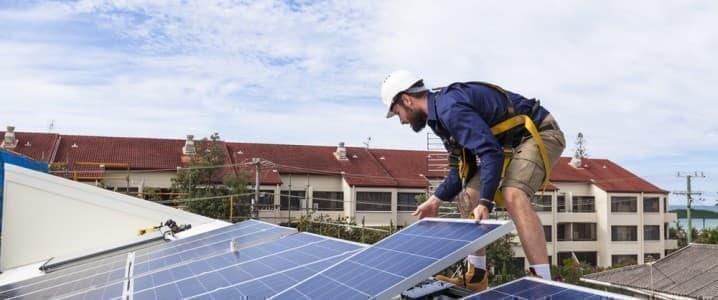Last year proved to be a banner year for the U.S. solar sector, with installed capacity rocketing 55% Y/Y to a record 33 GW, driven by robust growth by residential solar and high energy prices. It’s something of a minor miracle that the sector was able to record that kind of growth at a time when interest rates were going through the roof. The 10-year treasury yield jumped from half a percentage point in 2020 to just under five-percentage points in November 2023 as the Federal Reserve hiked rates to combat stubbornly high inflation in the aftermath of the Covid-19 pandemic. Despite the strong growth in installed capacity, solar stocks were badly hammered with the sector’s favorite benchmark, Invesco Solar ETF (NYSEARCA:TAN), crashing nearly 26% in 2023.
Last month, the solar and clean energy sector went wild after the Fed announced that it will keep short-term interest rates unchanged and penciled in three cuts in the current year, a potentially very bullish development for 2024. Unfortunately, solar stocks can’t seem to catch a proper break with the TAN ETF down 10.9% just 10 days into the new year. Perhaps this has got something to do with a December report by the Solar Energy Industries Association (SEIA) and Wood Mackenzie that predicted the U.S. solar sector will record a more modest 10% growth in installed capacity in 2024, with high-interest rates and the net metering policy in California seen as key headwinds. It’s also worth noting that interest rates have started creeping up with the markets on edge due to the uncertainty surrounding precisely when the Federal will start cutting rates. Further, the central bank has cautioned about the lingering possibility of a mild recession.
Solar installations, especially in the rooftop market, tend to be highly sensitive to interest rates. That’s the case because customers usually sign a 20- to 30-year purchase agreement to buy solar electricity from an installer, with no down payment. The installer then sells off any upfront subsidies and tax benefits and finances those long-term payments similar to what happens with mortgages or bonds. Higher interest rates squeeze margins for solar installers and sometimes forces them to counter by increasing prices. This is basically what has been ailing the solar sector over the past couple of years.
U.S. 10 Year Treasury Yield

Source: CNBC
But high interest rates do not hurt solar manufacturers alone: according to the International Energy Agency (IEA), a 5% increase in interest rates leads to a 33% increase in the levelized cost of electricity (LCOE) from wind and solar but only marginally for natural gas plants.
Thankfully for solar bulls, part of Wall Street remains bullish: Wells Fargo has predicted that solar stocks will rebound in 2024 with residential solar expected to outperform its utility-scale brethren due to their greater interest rate sensitivity.
"We expect residential solar to outperform utility-scale solar in 2024 given resi-solar's relative sensitivity to interest rate movements. We also expect resi solar to see a greater rate of change for growth given higher attach rates. In addition, key solar states (e.g. CA) are seeing sizable increases to utility rates this year, which should further support resi-solar economics in a falling rate environment," Wells Fargo has explained.
The Wall Street analysts have upgraded shares of Enphase Energy (NASDAQ:ENPH) and Nextracker (NASDAQ:NXT) to Overweight. ENPH price target has been raised to $141 from $98, good for 20.5% upside to current price while NXT has been lifted to $57 from $45, good for 35.7% upside. The firm has downgraded shares of First Solar (NASDAQ:FSLR) to Equal Weight and cut the price target to $187 from $215, still good for 12.7% upside while SunPower (NASDAQ:SPWR) has been downgraded to Underweight And the price target cut to $4 from $6, good for a mere 2.3% upside.
Qcells To Supply Microsoft With 12 Gigawatts Of American Solar Panels
South Korea’s solar equipment manufacturer Qcells has entered an agreement with U.S. enterprise software giant Microsoft Inc. (NASDAQ:MSFT) to supply the tech company with 12 Gigawatts of solar panels through 2032 in what has been hailed as one of the biggest deals of its kind. That’s enough solar energy to power nearly 2 million homes. Microsoft hopes the deal will help it achieve its ambitious goal to power its operations with 100% clean energy by 2025. Microsoft is the owner of Microsoft Azure, the second-largest of the top three public cloud platforms on the platform behind Amazon’s Inc.’s (NASDAQ:AMZN) AWS. Data centers are some of the most power-hungry operations today, consuming nearly 5% of global electricity output.
"How do we really make sure that we can meet those goals in this kind of an environment, as we see others coming in and doing the same thing? We have to really undertake things in a very strategic and thoughtful way," Bobby Hollis, Microsoft's vice president for energy, has said in an interview.
On its part, Qcells hopes that the collaboration with Microsoft will help the company create a solar supply chain in the United States that can compete with China.
By Alex Kimani for Oilprice.com
More Top Reads From Oilprice.com:
- China Looks To Play Peacemaker in the Middle East
- U.S., UK Shoot Down 21 Drones in Red Sea
- PJM: Electrification Will Raise Power Demand Peaks in the Long Term


















